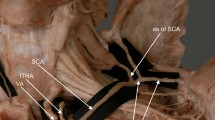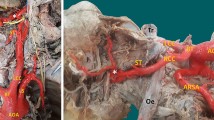Summary
Reinvestigation of the configuration of the human thyrocervical trunk revealed, that in the presently investigated specimens the dorsal scapular artery is a direct branch of the subclavian artery in approximately 75% of the cases, whereas in the remaining 25% it is derived from the thyrocervical trunk, either directly or via the transverse cervical artery (Nomina anatomica 1977). The internal thoracic artery participates in the thyrocervical trunk in more than 10% of the observed cases. Thus, both dorsal scapular and internal thoracic artery have to be considered as facultative branches of the thyrocervical trunk. According to our results, the subclavian artery must be considered as the most common site of origin of the dorsal scapular artery. This vessel may be replaced by another artery in about one fourth of the cases. A survey of studies on the origin of the dorsal scapular artery clearly demonstrates that it is not warranted to give an overall numerical proportion for the main modes of branching. As yet no satisfactory explanation for the high degree of variability of these subclavian branches has been given. Especially the widely held notion of differences related to race, which is based on Adachi's (1928) work, has turned out to be invalid. Interpretation of variability may rather be based, as a general concept, on the late acquisition of a thyrocervical trunk in phylogeny as well as in ontogeny.
Similar content being viewed by others
References
Adachi B (1928) Das Arteriensystem der Japaner. Vol 1, Maruzen Kyoto-Tokyo
Barry A (1951) The aortic arch derivatives in the human adult. Anat Rec 111:221–239
Bean RB (1905) A composite study of the subclavian artery in man. Am J Anat 4:303–328
Berg R, Smollich A (1962) Systematische Untersuchungen über die Aufzweigung der Aa. subclaviae bei Canis familiaris. Anat Anz 110:410–416
Cairney J (1925) The anomalous right subclavian artery considered in the light of recent findings on arterial development; with a note on two cases of an unusual relation of the innominate artery to the trachea. J Anat 59:265–296
Daseler EH, Anson BJ (1959) Surgical anatomy of the subclavian artery and its branches. Surg Gynec Obstetr 108:149–174
Chase RE, DeGaris CF (1948) The subclavian and axillary arteries in macacus rhesus compared with man. Amer J Phys Anthropol 6:85–109
DeGaris CF (1923) Modes of origin of the subclavian artery in whites and negroes, with report of a case of anomalous right subclavian artery. Anat Rec 26:235–240
DeGaris CF (1924) Patterns of branching of the subclavian artery in white and negroe stocks. Am J Phys Anthropol 7:95–107
Dolgo-Saburoff B (1933) Zur Frage der Lagebeziehungen zwischen der A. subclavia und der Scalenusmuskulatur beim Menschen. Anat Anz 76:97–113
Eisler P (1912) Die Muskeln des Stammes. In: Bardeleben K (ed) Handbuch der Anatomie des Menschen Vol 2/2/1 Fischer Jena
Elze C (1907) Beschreibung eines menschlichen Embryo von zirka 7 mm größter Länge unter besonderer berücksichtigung der Frage nach der Entwicklung der Extremitätenarterien und nach der morphologischen Bedeutung der lateralen Schilddrüsenanlage. Anat Hefte 35:409–492
Elze C (1960) Hermann Braus — Anatomie des Menschen, second ed, Vol 3 Springer Berlin-Göttingen-Heidelberg
Faller H (1952) Statistische Untersuchungen über Ursprung und Kaliber der Arteria transversa colli beim Menschen. Arch f Kreislaufforsch 18:161–166
Glidden EM, DeGaris CF (1936) Arteries in the chimpanzee (Pan spec.?) Am J Anat 58:501–527
Göppert E (1910) Über die Entwicklung von Varietäten im Arteriensystem. Morphol Jb 40:268–410
Gruber W (1872) Über die Variationen des ungewöhnlichen Ursprunges der Arteria mammaria interna und des Truncus thyreo-cervicalis. Virchows Arch 54:485–491
Hammer DL, Meis AM (1941) Thyroid arteries and anomalous subclavian in the white and the negroe. Am J Phys Anthropol 28:227–236
Holzapfel G (1899) Ungewöhnlicher Ursprung und Verlauf der Arteria Subclavia dextra. Anat Hefte 12:369–524
Huelke DF (1958) A study of the transverse cervical and dorsal scapular arteries. Anat Rec 132:233–245
Huelke DF (1962) The dorsal scapular artery — A proposed term for the artery to the rhomboid muscles. Anat Rec 142:57–61
Kägi J (1959) Beitrag zur Topographie der Arteria transversa colli. Eine Untersuchung an 134 Halshälften. Anat Anz 107:168–186
Lanz T von, Wachsmuth W (1955) Praktische Anatomie. Vol 1/2 Hals Springer Berlin-Göttingen-Heidelberg
Nomina anatomica (1977) fourth ed, Excerpta Medica Amsterdam-Oxford
Nomina anatomica veterinaria (1973) second ed, Holzhausen Vienna
Platzer W (1960) Das Arterien- und Venensystem. In: Hofer H, Schultz AH, Starck D (eds) Primatologia, Handbuch der Primatenkunde. Vol III/2 Karger Basel-New York
Platzer W (1974) Morphologie der Kreislauforgane. In: Helmcke JG, Starck D, Wermuth H (eds) Handbuch der Zoologie. Vol. 8/50 de Gruyter Berlin-New York
Quain R (1844) The anatomy of the arteries of the human body. Taylor and Walton London
Read WT, Trotter M (1941) The origins of transverse cervical and of transverse scapular arteries in american whites and negroes. Am J Phys Anthropol 28:239–247
Reichert P (1953) Der Truncus thyreocervicalis. Untersuchung an 150 Halshälften (Dissertation). Bull Soc Fribourg Science naturell 42:149–181
Rogers L (1930) The thyroid arteries considered in relation to their surgical importance. J Anat Physiol 64:50–61
Röhlich K (1934) Über die Arteria transversa colli des Menschen. Anat Anz 79:37–52
Röhlich K (1940) Über den Truncus thyreocervicalis des Menschen. Anat Anz 90:129–148
Sartor K, Freckmann N, Böker DK (1980) Related anomalies of origin of left vertebral and left inferior thyroid arteries. Neuroradiology 19:27–30
Shearer EM (1933) The development of the arteries in the anterior limb of the albino rat. Am J Anat 53:427–467
Skopakoff C (1965) Über die Variabilität der Abzweigung der A. subclavia und ihrer Hauptäste. Anat Anz 116:73–91
Thomson A (1892) Second annual report of the committe of collective investigation of the anatomical society of Great Britain and Ireland for the year 1890–1891. J Anat Physiol 26:76–80
Watzek G, Riedl P (1979) Regionale arterielle Zytostatikatherapie über einen Katheter in der Arteria axillaris. Österr. Chirurgenkongreß Innsbruck: 826–828
Weller GL Jr (1933) Development of the thyroid, parathyroid and thymus glands in man. Contr Embryol 24:95–139
Winterstein O (1927) Die Unterbindung der Arteria thyroidea inferior am Truncus thyreocervicalis. Ztrbl Chir 54:396–398
Zietschmann O, Ackerknecht E, Grau H (1943) Ellenberger-Baum Handbuch der vergleichenden Anatomie der Haustiere, 18th ed, Springer Berlin
Author information
Authors and Affiliations
Rights and permissions
About this article
Cite this article
Lischka, M.F., Krammer, E.B., Rath, T. et al. The human thyrocervical trunk: Configuration and variability reinvestigated. Anat Embryol 163, 389–401 (1982). https://doi.org/10.1007/BF00305554
Received:
Issue Date:
DOI: https://doi.org/10.1007/BF00305554




